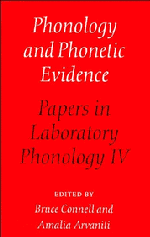Book contents
- Frontmatter
- Contents
- List of contributors
- Acknowledgments
- 1 Introduction
- I Features and Perception
- 2 Intermediate properties in the perception of distinctive feature values
- 3 A double-weak view of trading relations: comments on Kingston and Diehl
- 4 Speech perception and lexical representation: the role of vowel nasalization in Hindi and English
- 5 Processing versus representation: comments on Ohala and Ohala
- 6 On the status of redundant features: the case of backing and rounding in American English
- 7 The perceptual basis of some sound patterns
- II Prosody
- III Articulatory Organization
- Subject index
- Index of names
- Index of languages
3 - A double-weak view of trading relations: comments on Kingston and Diehl
Published online by Cambridge University Press: 03 May 2011
- Frontmatter
- Contents
- List of contributors
- Acknowledgments
- 1 Introduction
- I Features and Perception
- 2 Intermediate properties in the perception of distinctive feature values
- 3 A double-weak view of trading relations: comments on Kingston and Diehl
- 4 Speech perception and lexical representation: the role of vowel nasalization in Hindi and English
- 5 Processing versus representation: comments on Ohala and Ohala
- 6 On the status of redundant features: the case of backing and rounding in American English
- 7 The perceptual basis of some sound patterns
- II Prosody
- III Articulatory Organization
- Subject index
- Index of names
- Index of languages
Summary
Distinctive features and physical properties
Kingston and Diehl (hereafter, K&D) raise the controversial question of the relation of physical properties to phonological categories. I agree with many aspects of K&D's approach. Above all, I agree that categories can generally be specified as functions of acoustic properties without specific reference to articulatory events (Nearey, 1980, 1990). However, I have strong reservations about some of the specific claims made in their paper and my discussion will focus on these differences. I will evaluate aspects of K&D's work in light of a range of theoretical frameworks, including my own double-weak perspective (Nearey, 1992). While experimental evidence will be brought to bear on some specific issues with the usual technical detail, much of what I have to say is of a more speculative, philosophical character. For the sake of clarity, much of the discussion is relatively informal and incorporates several extended metaphors.
To situate K&D's approach within a range of other theories, consider first Figure 3.1 which is based on Lindau & Ladefoged's (1986) diagram of “traditional feature theories,” as exemplified by Stevens & Blumstein (1981). Characteristic of this account is the one-to-one relation of physical properties to distinctive features (hereafter, the term “feature” will be used exclusively to denote distinctive features in the usual sense), where each feature is associated with a single universal property. Features occupy quantal “sweet spots” in the articulatory-by-auditory space such that well-defined aspects of articulatory gestures map onto stable, distinctive auditory properties. Temporal-spectral discontinuities are critical for alignment but the properties themselves are essentially static.
- Type
- Chapter
- Information
- Phonology and Phonetic EvidencePapers in Laboratory Phonology IV, pp. 28 - 40Publisher: Cambridge University PressPrint publication year: 1995
- 2
- Cited by



